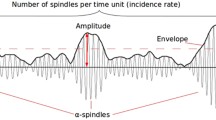Abstract
The sleep EEGs of eight medically refractory epileptic patients were examined as part of a double-blind, ABA crossover study designed to determine the effectiveness of EEG biofeedback for the control of seizures. The patients were initially reinforced for one of three EEG criteria recorded from electrodes placed over sensorimotor cortex: (a) suppression of 3- to 7-Hz activity, (b) enhancement of 12- to 15-Hz activity, or (c) simultaneous suppression of 3- to 7-Hz and enhancement of 11- to 19-Hz activity. Reinforcement contingencies were reversed during the second or B phase, and then reinstated in their original form during the final A′ phase. All-night polysomnographic recordings were obtained at the end of each conditioning phase and were subjected to both visual and computer-based power spectral analyses. Four of the patients showed changes in their nocturnal paroxysmal activity that were either partially or totally consistent with the ABA′ contingencies of the study. The spectral data proved difficult to interpret, though two trends emerged from the analyses. Decreases in nocturnal 4- to 7-Hz activity were correlated with decreases in seizure activity, and increases in 8- to 11-Hz activity were correlated with decreases in seizure activity. These findings were shown to strengthen the hypothesis that EEG biofeedback may produce changes in the sleep EEG that are related to seizure incidence.
Similar content being viewed by others
References
Agnew, H. W., Webb, W. B., & Williams, R. L. The first night effect: An EEG study of sleep.Psychophysiology 1966,2 263–266.
Daly, D. D. Circadian cycles and seizures. In M. A. B. Brazier (Ed.),Epilepsy: Its phenomena in man. New York: Academic Press, 1973, Pp. 215–233.
Finley, W. W. Effects of sham feedback following successful SMR training in an epileptic: Follow-up study.Biofeedback and Self-Regulation 1976,1 277–237.
Finley, W. W. Operant conditioning of the EEG in two patients with epilepsy: Methodologic and clinical considerations.Pavlovian Journal of Biological Science 1977,12 93–111.
Finley, W. W., Smith, H. A., & Etherton, M. D. Reduction of seizures and normalization of the EEG in a severe epileptic following sensorimotor biofeedback training: Preliminary study.Biological Psychology 1975,2 189–203.
Gibbs, E. L., & Gibbs, F. A. Diagnostic and localizing value of electroencephalographic studies in sleep.Journal of Research in Nervous and Mental Disease, Proceedings 1946,26 366–376.
Kaplan, B. J. Biofeedback in epileptics: Equivocal relationship of reinforced EEG frequency in seizure reduction.Epilepsia 1975,16 477–485.
Klass, D. W., & Fisher-Williams, M. Sensory stimulation, sleep, and sleep deprivation. In A. Redmond (Ed.),Handbook of electroencephalography and clinical neurophysiology, Amsterdam: Elsevier, 1976. Pp. 5–73.
Kuhlman, W. W.EEG feedback training of epileptic patients: Clinical and electroencephalographic analysis. Unpublished doctoral dissertation, Yale University, 1976.
Lubar, J. F., & Bahler, W. W. Behavioral management of epileptic seizures following EEG biofeedback training of the sensorimotor rhythm.Biofeedback and Self-Regulation 1976,1 77–104.
Lubar, J. F., Shabsin, H., Natelson, S. E., Holder, G. S., Whitsett, S. F., Pamplin, W. E., & Krulikowski, D. EEG operant conditioning in intractable epileptics.Archives of Neurology 1981,38 700–704.
Mostofsky, D. I., & Balaschak, B. A. Psychobiological control of seizures.Psychological Bulletin 1977,84 723–750.
Rechtschaffen, A., & Kales, A. (Eds.).A manual of standardized terminology, techniques and scoring system for sleep stages of human subjects (National Institutes of Health Publication No. 204) Washington, D.C.: U.S. Government Printing Office, 1968.
Schmidt, H. S., & Kaelbling, R. The differential laboratory adoption of sleep parameters.Biological Psychiatrist 1971,3 33–45.
Sterman, M. B. Effects of brain surgery and EEG operant conditioning on seizure latency following monomethylhydrazine in the cat.Experimental Neurology 1976,50 757–765.
Sterman, M. B. Effects of sensorimotor EEG feedback training on sleep and clinical manifestations of epilepsy. In J. Beatty & H. Legewie (Eds.),Biofeedback and behavior. New York: Plenum, 1977. Pp. 167–200.
Sterman, M. B. Power spectral analysis of EEG characteristics during sleep in epileptics.Epilepsia 1981,22 95–106.
Sterman, M. B., & Friar, L Suppression of seizures in an epileptic following sensorimotor EEG feedback training.Electroencephalography and Clinical Neurophysiology 1972,33 89–95.
Sterman, M. B., Howe, R. C., & MacDonald, L. R. Facilitation of spindle-burst sleep by conditioning of electroencephalographic activity while awake.Science 1970,167 1146–1148.
Sterman, M. B., LoPresti, R. W., & Fairchild, M. D.Electroencephalographic and behavioral studies of monomethylphadrazine toxicity in the cat. Wright-Patterson Air Force Base, Ohio: Technical Report AMRL-TR-69-3, 1969.
Sterman, M. B., & MacDonald, L. R. Effects of central cortical EEG feedback training on seizure incidence in poorly controlled epileptics.Epilepsia 1978,19 207–222.
Sterman, M. B., MacDonald, L. R., & Stone, R. K. Biofeedback training of the sensorimotor EEG rhythm in man: Effects on epilepsy.Epilepsia 1974,15 395–416.
Sterman, M. B., & Shouse, M. N. Quantitative analysis of training, sleep EEG and clinical response to EEG operant conditioning in epileptics.Electroencephalography and Clinical Neurophysiology 1980,49 558–576.
Wyler, A. R., Robbins, C. A., & Dodrill, C. B. EEG operant conditioning for control of epilepsy.Epilepsia 1979,20 279–286.
Author information
Authors and Affiliations
Additional information
This investigation was supported by a research grant from the Epilepsy Foundation of America. We are indebted to David I. Shaw for his assistance in manually scoring many of the sleep records used in the present study. We wish to thank Dr. Stephen E. Natelson of the Knoxville Neurosurgical Group for his frequent consultations and advice, and Ms. Maria Noel and Ms. Cookie Oakley for preparing the manuscript.
Rights and permissions
About this article
Cite this article
Whitsett, S.F., Lubar, J.F., Holder, G.S. et al. A double-blind investigation of the relationship between seizure activity and the sleep EEG following EEG biofeedback training. Biofeedback and Self-Regulation 7, 193–209 (1982). https://doi.org/10.1007/BF00998783
Issue Date:
DOI: https://doi.org/10.1007/BF00998783




